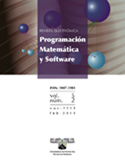Body Ar: Sistema educativo de anatomía basado en realidad aumentada
DOI:
https://doi.org/10.30973/progmat/2019.11.1/4Palabras clave:
software educativo, realidad aumentada, aprendizaje, aplicación móvilResumen
Este artículo describe el diseño de un software educativo (Body Ar) también aplicación móvil basada en realidad aumentada y enfocada a la educación básica, específicamente, sobre la anatomía humana que se estudia en tercer grado de primaria en la asignatura de Ciencias Naturales. Las principales características propuestas en el diseño del software es que los niños aprendan datos interesantes de una forma divertida, y entretenida, sobre cómo funciona el cuerpo humano por medio de la visualización de imágenes en tercera dimensión. Otra característica de Body Ar es brindarle al usuario la posibilidad de evaluar los conocimientos obtenidos conforme vaya avanzando con los temas proporcionados por medio de distintas actividades que le permitan al mismo tiempo reafirmar lo que va aprendiendo.
Citas
Sossa, H., Rayón, P., y Figueroa, J. Arquitectura basada en redes neuronales para el reconocimiento de rostros. Soluciones Avanzadas, 1998.
Rayón, P., and Sossa, H. A procedure to select the vigilance threshold for the ART2 for supervised and unsupervised training. LNAI 1793, pp. 389-400, Springer Verlag, 2000. https://doi.org/10.1007/10720076_35
Ríos Castrillón, F., Zapata Rendón, M. [en línea]. Producción realizada por el grupo Seminario sobre Informática Educativa conformada por estudiantes de Ingeniería de Sistemas. Universidad de Antioquia, 1999. Recuperado el 22 de octubre de 2017 de http://bochica.udea.edu.co/~frios/seminario_ie/index.html
Alonso García, E. (2016), [en línea]. Programas de ejercitación y práctica. Recuperado el 18 de octubre de 2017 de: https://ticleon.wikispaces.com/Ejemplos+del+alumnado+sobre+programas+de+ejercitaci%C3%B3n+y+pr%C3%A1ctica
Videocopilot. (2014), [en línea]. Tutoriales. Recuperado el 20 de Octubre de 2017, de https://www.videocopilot.net
Photoshoptutorials. (2013), [en línea]. Tutoriales photoshop. Recuperado el 20 de Octubre de 2017, de https://www.photoshoptutorials.ws
Tutoriales. (2013), [en línea]. Tutoriales varios. Recuperado el 20 de Octubre de 2017, de http://tutoriales.com/
Alarcon, Y. (2015), [en línea]. Ejemplos de software educativo. Recuoerado el 18 de Octubre de 2017, de https://www.mindmeister.com/es/148284754/ejemplosde-software-educativo
García Manzano, A. (2015), [en línea]. SIMULADORES SOFTWARE. Recuperado el 09 de Noviembre de 2017, de http://server-die.alc.upv.es/asignaturas/lsed/2002-03/Soft_Hard/software/windows/simuladores/index.html
Camba, J., Contero, M., & Salvador-Herranz, G. (2014, October). Desktop vs. mobile: A comparative study of augmented reality systems for engineering visualizations in education. In Frontiers in Education Conference (FIE), 2014 IEEE (pp. 1-8). IEEE. https://doi.org/10.1109/FIE.2014.7044138
Martínez, H., Skournetou, D., Hyppölä, J., Laukkanen, S., & Heikkilä, A. (2014). Drivers and bottlenecks in the adoption of augmented reality applications. Journal ISSN, 2368, 5956.
Wu, H. K., Lee, S. W. Y., Chang, H. Y., & Liang, J. C. (2013). Current status, opportunities and challenges of augmented reality in education. Computers & Education, 62, 41-49. https://doi.org/10.1016/j.compedu.2012.10.024
Radu, I., (2014). Augmented reality in education: a meta-review and cross-media analysis. Personal and Ubiquitous Computing, 18(6), 1533-1543. https://doi.org/10.1007/s00779-013-0747-y
Bower, M., Howe, C., McCredie, N., Robinson, A., & Grover, D. (2014). Augmented Reality in education– cases, places and potentials. Educational Media International, 51(1), 1-15. https://doi.org/10.1080/09523987.2014.889400
Webster, A., Feiner, S., MacIntyre, B., Massie, W., & Krueger, T. (1996, June). Augmented reality in architectural construction, inspection and renovation. In Proc. ASCE Third Congress on Computing in Civil Engineering (pp. 913-919).
Tang, S. L., Kwoh, C. K., Teo, M. Y., Sing, N. W., & Ling, K. V. (1998). Augmented reality systems for medical applications. IEEE engineering in medicine and biology magazine, 17(3), 49-58. https://doi.org/10.1109/51.677169
Vlahakis, V., Ioannidis, M., Karigiannis, J., Tsotros, M., Gounaris, M., Stricker, D., & Almeida, L. (2002). Archeoguide: an augmented reality guide for archaeological sites. IEEE Computer Graphics and Applications, 22(5), 52-60. https://doi.org/10.1109/MCG.2002.1028726
Kaufmann, H. and D. Schmalstieg, Mathematics and geometry education with collaborative augmented reality. Computers & Graphics, 2003. 27(3): p. 339- 345. https://doi.org/10.1145/1242073.1242086
Sin, A. K., & Zaman, H. B. (2010, June). Live Solar System (LSS): Evaluation of an Augmented Reality book-based educational tool. In Information Technology (ITSim), 2010 International Symposium in (Vol. 1, pp. 1-6). IEEE. https://doi.org/10.1109/ITSIM.2010.5561320
Visible Body (2013) [en linea]. Recuperado el 02 de Julio de /2018 de https://www.visiblebody.com/es/anatomy-andphysiology-apps/muscle-anatomy.
Visible Body (2013). Consultado el 02 de Julio de /2018 de https://www.visiblebody.com/es/anatomy-andphysiology-apps/skeleton-premium
Elliman, J., Loizou, M., & Loizides, F. (2016, September). Virtual reality simulation training for student nurse education. In Games and Virtual Worlds for Serious Applications (VS-Games), 2016 8th International Conference on (pp. 1-2).IEEE. https://doi.org/10.1109/VS-GAMES.2016.7590377
Taswell, S. K., Veeramacheneni, T., & Taswell, C. (2017, July). BrainWatch software for interactive exploration of brain scans in 3D virtual reality systems. In Engineering in Medicine and Biology Society (EMBC), 2017 39th Annual International Conference of the IEEE (pp. 3704-3707). IEEE. https://doi.org/10.1109/EMBC.2017.8037662
Descargas
Publicado
Cómo citar
Número
Sección
Licencia
Derechos de autor 2019 Programación Matemática y Software

Esta obra está bajo una licencia internacional Creative Commons Atribución 4.0.
Usted es libre de:
 |
Compartir — compartir y redistribuir el material publicado en cualquier medio o formato. |
 |
Adaptar — combinar, transformar y construir sobre el material para cualquier propósito, incluso comercialmente. |
Bajo las siguientes condiciones:
 |
Atribución — Debe otorgar el crédito correspondiente, proporcionar un enlace a la licencia e indicar si se realizaron cambios. Puede hacerlo de cualquier manera razonable, pero de ninguna manera que sugiera que el licenciador lo respalda a usted o a su uso. |
| Sin restricciones adicionales: no puede aplicar términos legales o medidas tecnológicas que restrinjan legalmente a otros a hacer cualquier cosa que permita la licencia. |










